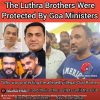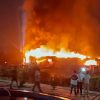Goa is abuzz with excitement as vintage bike and car owners, users, collectors and fans are decking […]

SELF CARE AT THE WORKPLACE 24X7
July 27- Aug 02 2024, MIND & BODY, HEART & SOUL July 26, 2024A Self-Care Awareness Month Special!
The World Health Organization has declared the month starting from June 24 as Self-Care Awareness Month. It ended on July 24 which is observed as International Self- Care Day. Learn more about self-care in this interview with Dr Amit Dias who says, “Self-care is not an expense, it is an investment.”
An Q/A interview with Dr Amit Dias
Goan Observer: Let’s start by understanding what is meant by self-care?
Dr Amit Dias: Self-care, it’s a decision that empowers individuals to look after their own health. We often get engrossed in taking care of others and ignore ourselves. By promoting self care, people are encouraged to work towards promoting and maintaining their health, preventing disease, and coping with illness and disability, with or without the help of the health care provider. Self-care is not an expense, it is an investment.
Those who think they do not have time for self-care today, will sooner or later, be forced to make time for an illness. So make time for yourself – it’s never too late to start.
Engaging in self-care practices can reduce stress levels, increase productivity at work, and improve overall job satisfaction. Research has shown that employees who take regular breaks, eat healthily, and exercise, tend to have lower levels of stress and higher levels of engagement and productivity. So go ahead and love yourself — it is a decision that will transform your life.
Q: Yes, that sounds good….but one could argue that self-care is overindulgence! What would you say about it?
A: There are several myths about self-care and it is often misunderstood. There is more to self-care than expensive body massages, face masks and bubble baths. Self-care is about making conscious changes in our lifestyles behaviors and thinking processes to bring about the best version of you and contribute to your wellbeing. More than that it brings out the most favourite version of you.
Remember you can only pour from a cup that is full. You can only do good and help others around you if you are healthy yourself. So you are not only looking after yourself but also after others. It’s not time-consuming, it’s not selfish, it’s not a one-time affair.
Q: Why do we observe the self-care day on July 24?
A: This has a very interesting reason…. Self-care has to be done 24 X 7. In order to highlight this WHO observes the day on 24/7 (July 24). We need to practice self-care 24X7 – 24 hours a day, seven days a week. We have to observe it at home as well as our workplace.
Q: How can we observe self-care at the workplace?
A: The workplace can be a source of stress, long hours and sometimes even physical strain, all of which can lead to chronic conditions and mental stress if not managed properly. Observing self-care at the workplace can be done in various ways. Here are some effective strategies:
Regular Breaks: Taking short breaks throughout the day can help reduce stress and prevent burnout. Even a five-minute walk can be beneficial.
Healthy Eating: Maintaining a balanced diet by incorporating fruits, vegetables and whole grains can boost energy levels and concentration.
Physical Activity: Incorporating physical activities such as stretching exercises, walking meetings, or using a standing desk can improve physical health.
Mindfulness & Relaxation: Practices like deep breathing, meditation, or yoga can help in managing stress and improving mental clarity.
Social Support: Building a supportive work environment where colleagues can share their concerns and support each other can significantly improve mental well-being.
Ergonomics: Ensuring that your workstation is ergonomically set up to prevent musculoskeletal problems is crucial.
Q: Can you elaborate a bit more on ergonomics? How can one adopt ergonomics in the workplace?
A: Here are several practical ways to adapt ergonomics in the workplace:
*Adjustable Chairs: Use chairs that can be adjusted for height, backrest angle, and lumbar support. This ensures that the chair supports the natural curve of the spine, reducing the risk of back pain.
- Desk Height: Ensure that desks are at a height where the forearms are parallel to the floor when typing, and the wrists are in a neutral position.
*Monitor Placement: Place the computer monitor at eye level and about an arm’s length away. This prevents neck strain and encourages a neutral head position.
*Keyboard and Mouse Position: Keep the keyboard and mouse close to the body to avoid overreaching. A keyboard tray can help maintain a comfortable typing angle.
*Foot Rests: If the feet do not comfortably reach the floor, use a footrest to ensure the thighs are parallel to the ground.
*Lighting: Ensure adequate lighting to reduce eye strain—position screens to avoid glare from windows or overhead lights.
*Document Holders: Use document holders to keep reference materials at the same height and distance as the monitor to avoid repetitive neck movements.
*Breaks & Movement: Encourage regular breaks to stand, stretch, and move around. This reduces the risk of musculoskeletal problems from prolonged sitting. On World Yoga Day this year, the government introduced the break for yoga and promoted a few chair exercises during the break.
Q: What advice would you give to people who work on computers for long periods?
A: For those who spend long hours working on computers, here are some key ergonomic suggestions:
- Practice the 20-20-20 Rule: Every 20 minutes, take a 20-second break to look at something 20 feet away. This helps reduce eye strain.
- Posture Check: Maintain a neutral posture with your back straight, shoulders relaxed, and elbows close to your body. Avoid slouching or leaning forward.
- Use a Proper Chair: Invest in an ergonomic chair that supports the natural curve of your spine and allows your feet to rest flat on the floor or on a footrest.
- Adjust Your Screen: Position your monitor so that the top of the screen is at or just below eye level. This prevents neck strain.
- Keyboard & Mouse Positioning: Keep your keyboard and mouse at the same level and close enough to your body to prevent overreaching.
- Hand & Wrist Position: Keep your wrists in a neutral position, not bent up or down, while typing. Wrist rests can help maintain this position.
- Standing Desks: Consider using a standing desk or a desk converter to alternate between sitting and standing throughout the day.
- Stretching & Movement: Incorporate regular stretching and movement breaks into your routine. Simple stretches for the neck, shoulders, back, and wrists can help alleviate tension and prevent injury.
Q: Any message for our readers?
A: SELF-CARE IS NOT THE SAME AS BEING SELFISH. It is estimated that 4.3 billion people have inadequate access to essential healthcare services. 1 in 5 individuals live in regions with a humanitarian crisis with challenged health care delivery.
Do practice self-care 24 X 7 and encourage others to do it as well. Together we can build a healthy society that cares for themselves and others as well. Promoting self-care can strengthen primary health care and help us achieve our goals. Self-care is for a life time, make your self-care promise today!

















